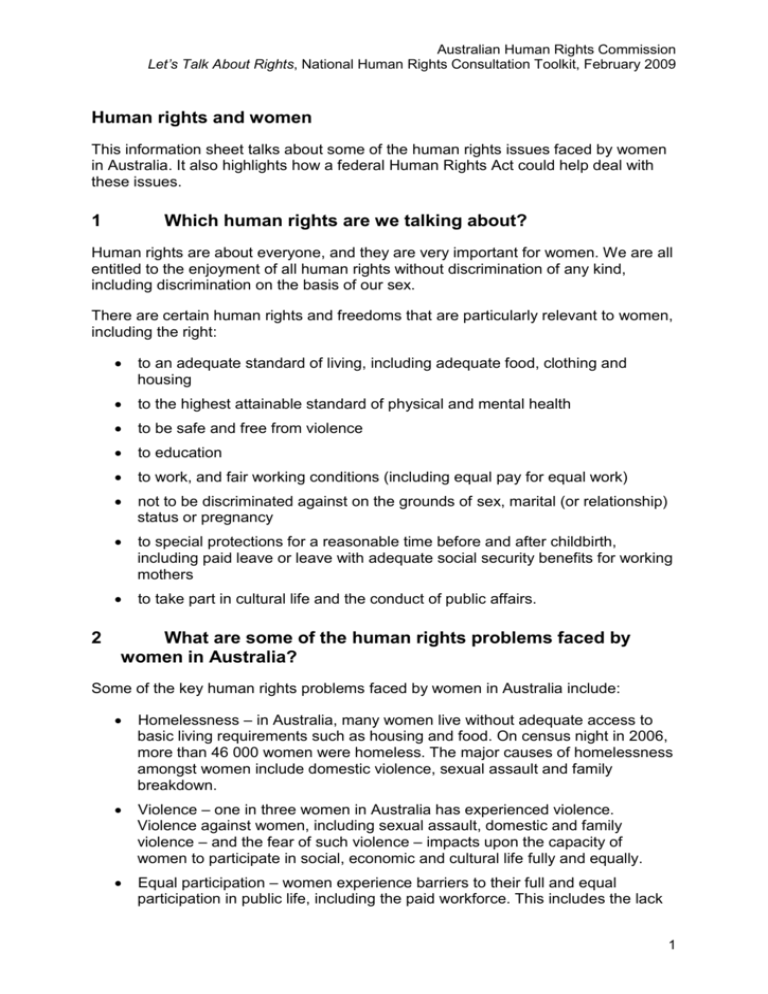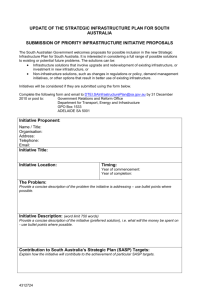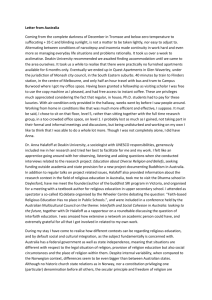
Australian Human Rights Commission
Let’s Talk About Rights, National Human Rights Consultation Toolkit, February 2009
Human rights and women
This information sheet talks about some of the human rights issues faced by women
in Australia. It also highlights how a federal Human Rights Act could help deal with
these issues.
1
Which human rights are we talking about?
Human rights are about everyone, and they are very important for women. We are all
entitled to the enjoyment of all human rights without discrimination of any kind,
including discrimination on the basis of our sex.
There are certain human rights and freedoms that are particularly relevant to women,
including the right:
2
to an adequate standard of living, including adequate food, clothing and
housing
to the highest attainable standard of physical and mental health
to be safe and free from violence
to education
to work, and fair working conditions (including equal pay for equal work)
not to be discriminated against on the grounds of sex, marital (or relationship)
status or pregnancy
to special protections for a reasonable time before and after childbirth,
including paid leave or leave with adequate social security benefits for working
mothers
to take part in cultural life and the conduct of public affairs.
What are some of the human rights problems faced by
women in Australia?
Some of the key human rights problems faced by women in Australia include:
Homelessness – in Australia, many women live without adequate access to
basic living requirements such as housing and food. On census night in 2006,
more than 46 000 women were homeless. The major causes of homelessness
amongst women include domestic violence, sexual assault and family
breakdown.
Violence – one in three women in Australia has experienced violence.
Violence against women, including sexual assault, domestic and family
violence – and the fear of such violence – impacts upon the capacity of
women to participate in social, economic and cultural life fully and equally.
Equal participation – women experience barriers to their full and equal
participation in public life, including the paid workforce. This includes the lack
1
Australian Human Rights Commission
Let’s Talk About Rights, National Human Rights Consultation Toolkit, February 2009
of a legislated paid maternity leave scheme, discrimination and sexual
harassment.
Gender gap in income – many women in Australia have lower earnings over
their lifetime than men. Women working full time earn 84 cents in the male
dollar; they are more likely than men to leave the workforce to take up caring
responsibilities; and, compared to men, have significantly less retirement
savings.
Importance of maternity leave
‘With the birth of Ethan this June, I had a caesarean again and it is very different. We
live upstairs so physically it’s hard. I haven’t had time to relax, and take it easy.
Coping on your own as a couple with a new baby, getting to know the baby, then the
financial pressures, and then going back to work [two weeks after the birth] – it is
very hard. I’m tired, irritable. And I can’t see my baby! I wanted to bring him in and
keep him under my desk!’
Human Rights and Equal Opportunity Commission, A time to value: Proposal for a
national paid maternity leave scheme (2002), p 53.
Domestic violence and housing
‘Domestic violence is an issue that is hard to discuss. There is an element of shame.
You are being violated but there is also love and loyalty attached to it. You think
everyone else is leading a normal life. It was difficult to communicate with my
colleagues. It affected me mentally and physically.’ (Listening Tour 2008, Tasmania)
‘I have had big troubles with housing. [I have ended up] going to refuges [or] staying
with relatives and friends. How can you stay stable and provide good parenting to
your children without a roof over your head? I was made to feel like a mental case.’
Listening Tour 2008, New South Wales, Human Rights and Equal Opportunity
Commission.
Financial independence
‘As a baby boomer approaching retiring age and having spent most of my years
raising children, I have very little hope of retiring and will need to work for as long as
possible. I will not be independent financially. Many women I know are the main
income earner, sometimes this will be off farm income in order to maintain the family
farm and lifestyle due to drought etc, or because they may have a husband with a
disability. The pressure is really on women who have not been high income earners
and the outlook for the future is bleak. I see many tired women who are working
fulltime, supporting husbands and trying to be a helpful grandparent. None of these
things is easy without financial independence.’
Listening Tour Diary (Dec, 2007), Human Rights and Equal Opportunity Commission.
2
Australian Human Rights Commission
Let’s Talk About Rights, National Human Rights Consultation Toolkit, February 2009
3
What are the limitations of existing human rights
protections for women?
There are limited human rights protections for women at the moment.
Federal politicians and public servants don’t have to consider the rights of women
when developing and implementing new laws and policies on issues such as
housing, health, education, employment and superannuation.
If you feel that you have experienced sexual harassment or discrimination based on
sex, pregnancy, marital (or relationship) status or family responsibilities, you can
make a complaint to the Australian Human Rights Commission under the federal Sex
Discrimination Act 1984 (Cth) (SDA). Or, you can make a complaint under state or
territory anti-discrimination laws.
However, there are limitations to this protection. For example:
women are not protected from discrimination and sexual harassment in all
areas of public life
women are not able to make a complaint about discrimination at work because
of caring responsibilities such as looking after older parents
working women do not have a right to minimum paid maternity leave.
Women who are sacked because of their sex, marital status, pregnancy or family
responsibilities may also be protected by the Workplace Relations Act 1996 (Cth).
4
How could we improve human rights protections for
women?
The Australian Human Rights Commission supports a Human Rights Act for
Australia.
A Human Rights Act that protects economic, social and cultural rights (such as the
rights to adequate housing, health and an adequate standard of living) could make a
difference to the lives of women in Australia. It could improve the policies, procedures
and services that many women encounter daily.
A Human Rights Act could help prevent the human rights problems faced by women
and provide remedies for those human rights breaches that were not prevented. It
could make a difference in protecting and promoting the rights of women by requiring
our government to consider carefully how decisions impact on their human rights.
If Australia had a Human Rights Act, it could:
make the federal Parliament consider how laws impact on human rights –
for example, any debate on changes to workplace relations, taxation or social
security laws would need to take into account the different needs of women
make the federal government respect human rights when developing
policy – for example, when considering appropriate support for working
mothers
3
Australian Human Rights Commission
Let’s Talk About Rights, National Human Rights Consultation Toolkit, February 2009
make public servants respect human rights when making decisions and
delivering services – for example, when providing housing to women and
children at risk of homelessness
provide a range of enforceable remedies if a government authority breaches
human rights.
How the UK Human Rights Act helped to protect a family
The United Kingdom has had a Human Rights Act since 1998. The British Human
Rights Institute tells the story of a woman who fled domestic violence with her
children. The woman’s husband attempted to track the family down and they moved
towns whenever he discovered their whereabouts. The family eventually arrived in
London and were referred to the local social services department. Social workers told
the mother that she was an ‘unfit’ parent and that she had made the family
intentionally homeless. They said that her children had to be placed into foster care.
An advice worker helped the mother to challenge this claim on the basis of the right
to respect for family life. As a result, the family were told that they could remain
together and that the social services department would provide the deposit if they
could secure private rented accommodation.
British Institute of Human Rights, The Human Rights Act – Changing Lives (2nd ed,
2008), p 18.
Over the longer term, a Human Rights Act would also be a powerful tool for fostering
a stronger human rights culture in Australia by promoting greater understanding and
respect among all people in Australia.
In addition to a Human Rights Act, there is a range of other ways in which the human
rights of women could be better promoted and protected in Australia. For example:
enhanced protection of human rights in the Australian Constitution
stronger protections under the existing Sex Discrimination Act
guaranteed paid maternity leave
better protection from evictions from housing
a strong national plan to address violence against women
a National Human Rights Action plan, including a focus on the rights of women
a national public education program about human rights, including women’s
rights.
These and other measures could make a positive difference to human rights
protection.
5
Where else can I find out about women’s human rights?
Australian Human Rights Commission:
www.humanrights.gov.au/sex_discrimination/index.html
4








